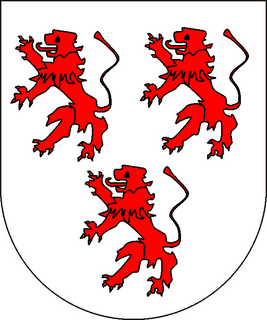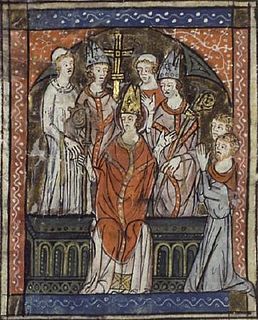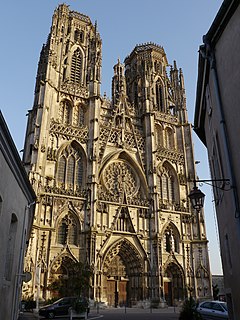Related Research Articles

Jean de Lorraine was the third son of the ruling Duke of Lorraine, and a French cardinal, who was archbishop of Reims (1532–1538), Lyon (1537–1539), and Narbonne (1524–1550), bishop of Metz, and Administrator of the dioceses of Toul, Verdun, Thérouanne, Luçon, Albi, Valence, Nantes and Agen (1538–1550). He was a personal friend, companion, and advisor of King Francis I of France. Jean de Lorraine was the richest prelate in the reign of Francis I, as well as the most flagrant pluralist. He is one of several cardinals known as the Cardinal de Lorraine.

Antoine Augustin Calmet, O.S.B., a French Benedictine monk, was born at Ménil-la-Horgne, then in the Duchy of Bar, part of the Holy Roman Empire.

The Roman Catholic Archdiocese of Cambrai is an archdiocese of the Latin Rite of the Roman Catholic Church in France, comprising the arrondissements of Avesnes-sur-Helpe, Cambrai, Douai, and Valenciennes within the département of Nord, in the region of Nord-Pas-de-Calais. The current archbishop is Vincent Dollmann, appointed in December 2000. Since 2008 the archdiocese has been a suffragan of the Archdiocese of Lille.

Vedast or Vedastus, also known as Saint Vaast or Saint Waast, Saint Gaston in French, and Foster in English was an early bishop in the Frankish realm.

The Diocese of Toul was a Roman Catholic diocese seated at Toul in present-day France. It existed from 365 until 1824. From 1048 until 1552, it was also a state of the Holy Roman Empire.

Saint-Hippolyte is a commune in the Haut-Rhin department in Grand Est in north-eastern France.

Lièpvre is a commune in the Haut-Rhin department in Grand Est in north-eastern France. A monastery was built here in the eighth century by Saint Fulrad, who filled it with relics of Saint Cucuphas and Saint Alexander.

The Roman Catholic Diocese of Nancy and Toul is a diocese of the Latin Rite of the Roman Catholic Church in France. After a considerable political struggle between Louis XV, Louis XVI, and the Dukes of Lorraine, the diocese was erected by Pope Pius VI on 17 December 1777. The diocese is currently suffragan to the Archdiocese of Besançon.

Saint Mansuetus was the first Bishop of Toul.

Toul Cathedral is a Roman Catholic church in Toul, Lorraine, France. It is a classic example of late Gothic architecture in the Flamboyant style. The cathedral has one of the biggest cloisters in France.

The Roman Catholic Diocese of Saint-Dié (Latin: Dioecesis Sancti Deodatiis; French: Diocèse de Saint-Dié is a diocese of the Latin Rite of the Roman Catholic Church in France. The diocese has the same boundaries as the department of the Vosges. The bishop has his throne at Saint-Dié Cathedral in the town now named Saint-Dié-des-Vosges, but since 1944 has lived in Épinal, capital of the département. The diocese is currently a suffragan of the Archdiocese of Besançon. The current bishop is Jean-Paul Marie Mathieu, who was appointed in December 2005.
The Abbey of St. Evre was a Benedictine, later Cluniac, monastery in Toul, France. Established in or just before 507, it was the oldest monastery in Lorraine and of great significance in the monastic and religious reforms in the Rhine and Moselle region of the 10th and 11th centuries.
Richer of Senones was a monk and chronicler of Senones Abbey in Lorraine, a traveller and one of the very few chroniclers or historians of the Vosges whose works have survived complete.
The Sisters of the Christian Doctrine of Nancy (D.C.) is a religious order of the Roman Catholic Church for women, whose primary mission is the teaching and nursing of the poor. Its members place after their names the order's initials, D.C. They are known as the "Vatelottines" in honor of their founder, and also "School Sisters", especially in Germany and Luxembourg, because of their primary mission. They should not be confused with the Spanish order of the Sisters of the Christian Doctrine (Mislata), which was founded in 1880.
Saint Ursus of Toul, known in French as Saint Ours, was a 5th-century French bishop of Toul and a saint of the Roman Catholic Church with a locally venerated feast day celebrated on 1 March.

Saint Amon of Toul was the second recorded bishop of Toul and is venerated as a saint by the Roman Catholic Church.
Saint Alchas was the third bishop of Toul. He is venerated as a saint by the Roman Catholic Church.
Saint Aprus was the seventh bishop of Toul. He has been considered a saint in Toul since the 10th century. His feast day is celebrated on 15 September.
Trifsorich or Trisorik of Toul was the 9th bishop of Toul. Trifsorich succeeded Albaud of Toul in 525, but very little is known about him.
Saint Gelsimus of Toul, also known as Saint Celsin, was the fourth bishop of Toul. He is venerated as a saint by the Roman Catholic Church.
References
- ↑ Histoire du diocèse de Toul et de celui de Nancy, par l'abbé Pierre-Étienne Guillaume. Nancy. Thomas et Pierron. 1866
- ↑ Eugène Martin, Histoire des diocèses de Toul, de Nancy et de Saint-Dié, vol. 2, éd. A. Crépin-Leblond, 1901[ page needed ]
- ↑ Marcelin Chéry, Saint Epvre, VIIe évêque de Toul: sa vie, son abbaye, son culte, ed. Poussièlgue, 1866,[ page needed ]
- ↑ Jean-Luc Fray, Villes et bourgs de Lorraine: réseaux urbains et centralité au Moyen Âge, Presses universitaires Blaise Pascal, décembre 2007.[ page needed ]
- ↑ Victor-Emmanuel Tihay, La vie des Saints: lectures chrétiennes pour tous les jours de l'année, contenant toutes les légendes du bréviaire romain et des notices sur les saints honorés dans les anciennes provinces de Lorraine et de Champagne, éd. J. B. Laurent, 1865[ page needed ]